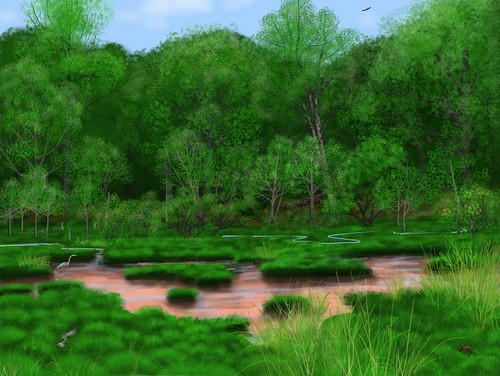General Discussion
Related: Editorials & Other Articles, Issue Forums, Alliance Forums, Region ForumsDon't you wish you could have seen it? America before colonialism started terra forming?

http://popular-archaeology.com/issue/09012013/article/research-allows-reconstruction-of-precolonial-landscape-in-eastern-u-s
Popular Archaeology
exploring the past
Vol. 12 09012013 -
Research Allows Reconstruction of Pre-colonial Landscape in Eastern U.S.
Wed, Nov 13, 2013
It's all in the leaves.
Research Allows Reconstruction of Pre-colonial Landscape in Eastern U.S.
Other than cities, towns, and road systems, what we see today on the eastern mid-Atlantic U.S. landscape is quite different than what Native Americans saw before European contact. It was a world that essentially vanished as colonizers took root and transformed their environment to meet their needs. This is nothing new to most historians.
Thanks to recent research, however, scientists can now reconstruct that landscape with accuracy, providing information that may also help manage the environment of today.
It all has to do with milldams and leaves. According to a team of geoscientists, sediment behind milldams in Pennsylvania preserved leaves deposited just before European contact, providing a glimpse of ancient forests. To get to this, they examined samples of 300-year-old leaves buried by sediment backed up behind Denlinger's Mill in Lancaster County. The leaves fell from trees from above the location of the dam. As sediment rapidly covered and "entombed" the leaf layer, the leaves that were deposited before the construction of the dam were preserved intact. ...more
hunter
(38,317 posts)Some were nice places, some were not, with a lot of people muddling-through-in-between places, suffering either capricious environments or capricious political-religious traditions, or worse, both.
Our own civilization is headed into a bad "worse, both" phase, mostly of our own making.
But humans will not be able to blame gods for this catastrophe. We've created a world civilization that is not sustainable.
Skidmore
(37,364 posts)what the land looked like before settler started cutting forests and fencing fields. I find the use of clues in the soil to get at the flora from earlier time periods to be a fascinating study.
hunter
(38,317 posts)It simply wasn't "cultivation" as the European invaders understood it.
The same was true in Australia, New Zealand, New Guinea, Hawaii, and all the other places Europeans labeled the locals "savages."
These places generally enjoyed carefully maintained permacultures. People planted useful trees for their grandchildren and optimized the environment for game animals and edible plants.
The people from Western Europe didn't see that.
csziggy
(34,136 posts)http://welikia.org/about/overview/
They have an interactive map that can be explored - it's amazing!